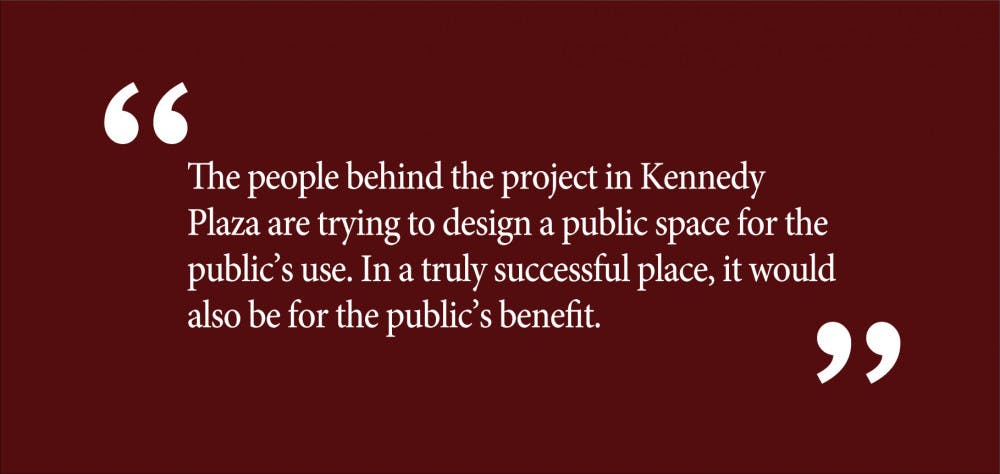I like to think of Kennedy Plaza as the “heart” of Rhode Island. Designer Don Powers would call it “the living room” of the Ocean State, or what I would call the yellow submarine of the octopus’ garden. Recent discussion about the planned renovations to Kennedy Plaza has me thinking about its fate. Currently, as Bonnie Nickerson, director of the Department of Planning and Development for the City of Providence, explained, the plan for Kennedy Plaza is to consolidate bus stops, improve pedestrian safety, improve vehicle circulation and “create a vibrant public space.”
As of now, Kennedy Plaza works for the machine; its primary purpose, in effect, is to serve the cars and buses. And those cars and buses are not nice: They’re loud, they’re ugly and most of all they can be dangerous. Providence’s current plan for Kennedy Plaza, funded by the state and the city, is a welcome first step, but I think it could go further.
I believe Kennedy Plaza needs to become a more meaningful space for people, not just buses. This space belongs to the residents of the city and should provide a wonderful experience to everyone who visits. The idea of a city plaza, from Florence to León to New York, is to provide a space that’s appealing for everybody. Imagine coffee tables spilling out into Westminster Street, children playing jump rope, young couples holding hands and ice skating. There’s magic to be had; the difficulty is allocating funds to anything besides infrastructure and transportation plans.
Renovation plans have come to fruition, and construction will begin in 2019 for moving the buses to Washington Street. There will no longer be stops on Exchange Terrace, East Approach or Fulton Street. This should make the plaza safer for pedestrians, a welcome first step, but the next step would be making it fun and conducive to recreational use.
For me, a caffeine junkie with a lust for Paris lights, Kennedy Plaza’s appeal to leisure would definitely involve a coffee shop and maybe a rose garden and a fountain shaped like Apollo. However, the current plan is intentionally vague, with only a specific mention to “public art.” Kennedy Plaza will be a nice space, and the city wants to make it happen, but at the moment, for reasons that make a lot of sense, pragmatism rules and beauty takes a backseat in the unraveling of this plan.
Now, it’s worth noting that any plan to improve a city comes at a cost — gentrification. Typically, this involves displacing citizens due to increased property values and rents. The thing about Kennedy Plaza, however, is that it’s not currently a residential area. While retail values might go up, the cost of living should not change significantly. Creating a public space that welcomes everyone and enables everyone to come together to have a positive experience can facilitate social equality and improved community experience when done cautiously and thoughtfully.
Look at public spaces in countries around the world. Places that come to mind are Denmark and Colombia. The Copenhagen-based landscape architecture, real estate and planning group Gehl’s projects in Denmark and around the world use innovative concepts like gardens and children’s education as a foundation for improving urban quality of life.
In Colombia, the city of Medellin provides an interesting and important example of urban design and infrastructure as an attempt at improving socioeconomic equity. Over the past 10 years, former Mayor Sergio Fajardo led a project in what the city of Medellin terms “social urbanism.” By improving services, public spaces and transportation systems, the city reinvented itself. Once an overpopulated hub for crime and inequity, the city has made huge steps for the advancement of quality of life for its fast-growing population.
The city’s experimental plan created environmentally friendly improvements like a garden that absorbs toxins from a major landfill, a “greenbelt” walking/biking path to curb urban sprawl and transportation that promotes access for everybody to medical care and work. This project, which earned Medellin the Urban Land Institute’s award for “most innovative city,” has its downside. In the completion of the project, people were displaced from their homes — a result of change in residential areas. Violence still remains a serious problem in the city, and the new designs replaced some of the original charm many of its citizens held dear.
Maintenance, and continued improvement, are integral to the success of a project on this scale. Still, it’s important to note how much public safety and experience have both improved: Murder rates are lower than they have been, educational initiatives have improved and art galleries, libraries and public spaces now flourish.
While there are no guarantees, the people behind the project in Kennedy Plaza are trying to design a public space for the public’s use. A truly successful public space would also be for the public’s benefit.
For now, however, Kennedy Plaza improvements have to keep safety as their primary concern, and that’s simply working toward a basic quality of life issue for Providence citizens. Maybe, over the next five years or so, Kennedy Plaza will become a heart for the people of Rhode Island, but for now it’s still just arteries and veins getting buses from one place to another. Call me a dreamer, but next time I’m at Haven Bros doing damage to my own heart, I’ll be thinking of how, one day, Kennedy Plaza too might become a heart with a pulse in the city of Providence.
Elizabeth Toledano ’20 can be reached at elizabeth_toledano@brown.edu. Please send responses to this opinion to letters@browndailyherald.com and other op-eds to opinions@browndailyherald.com.





